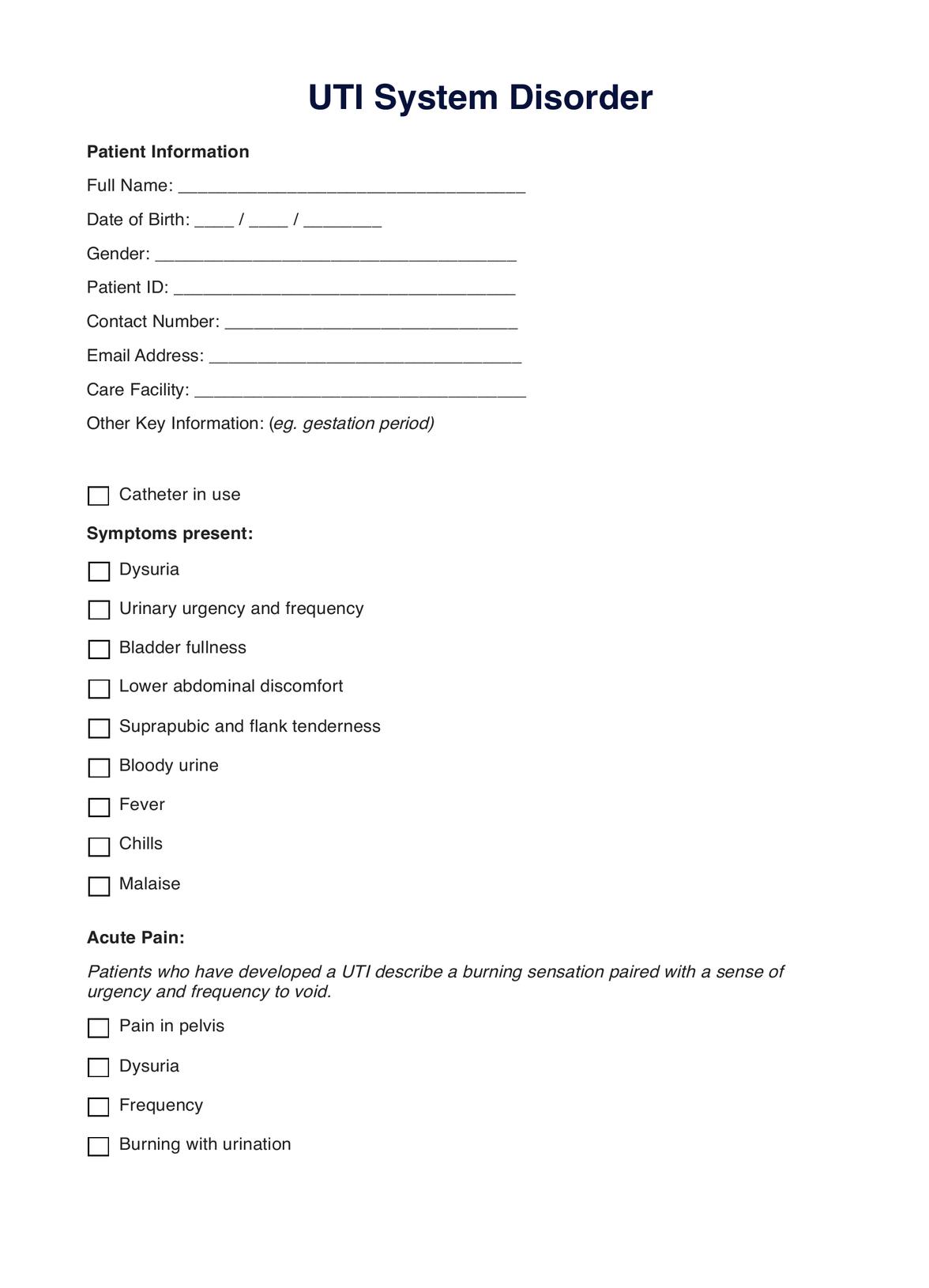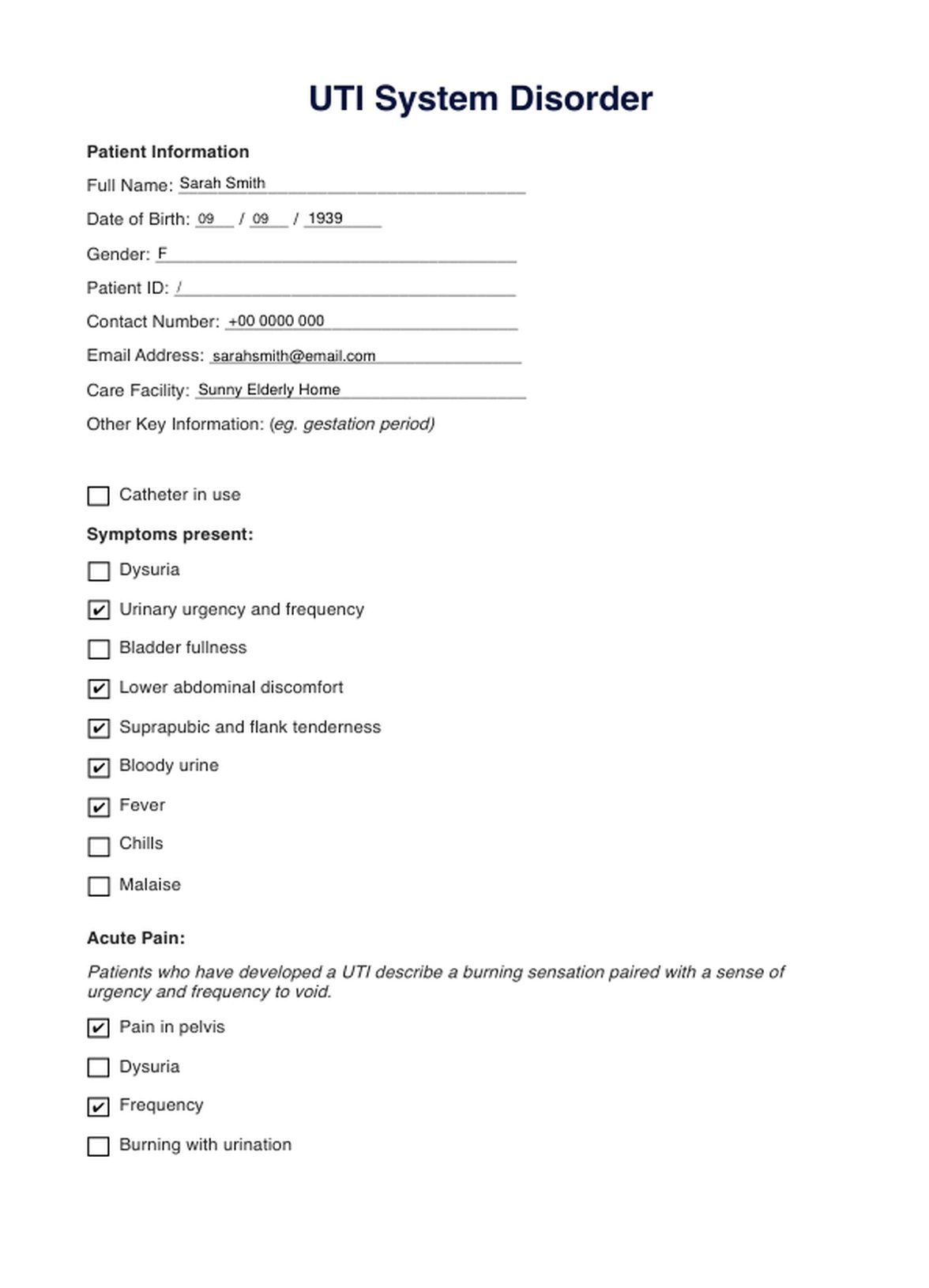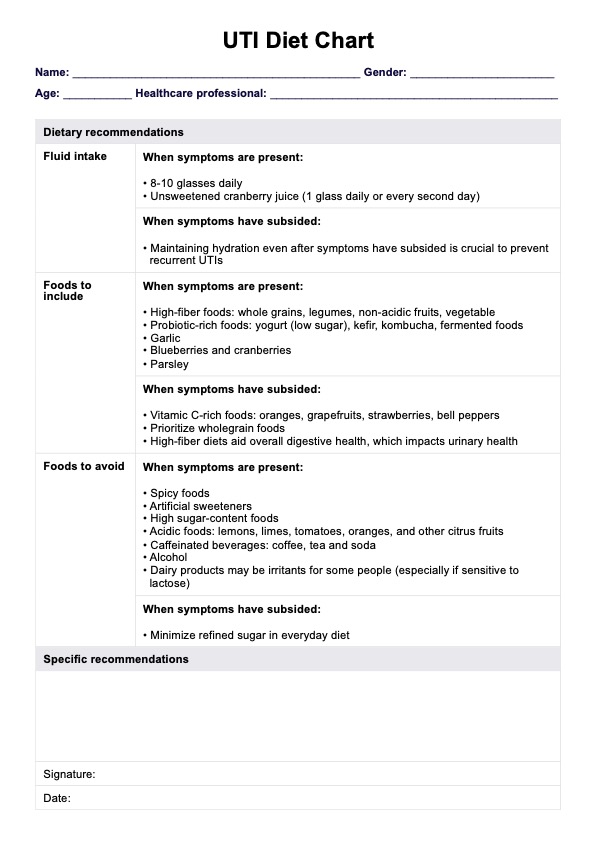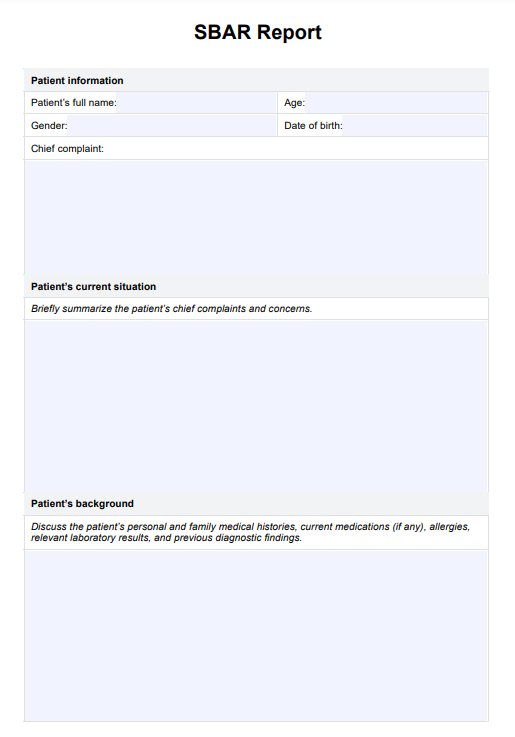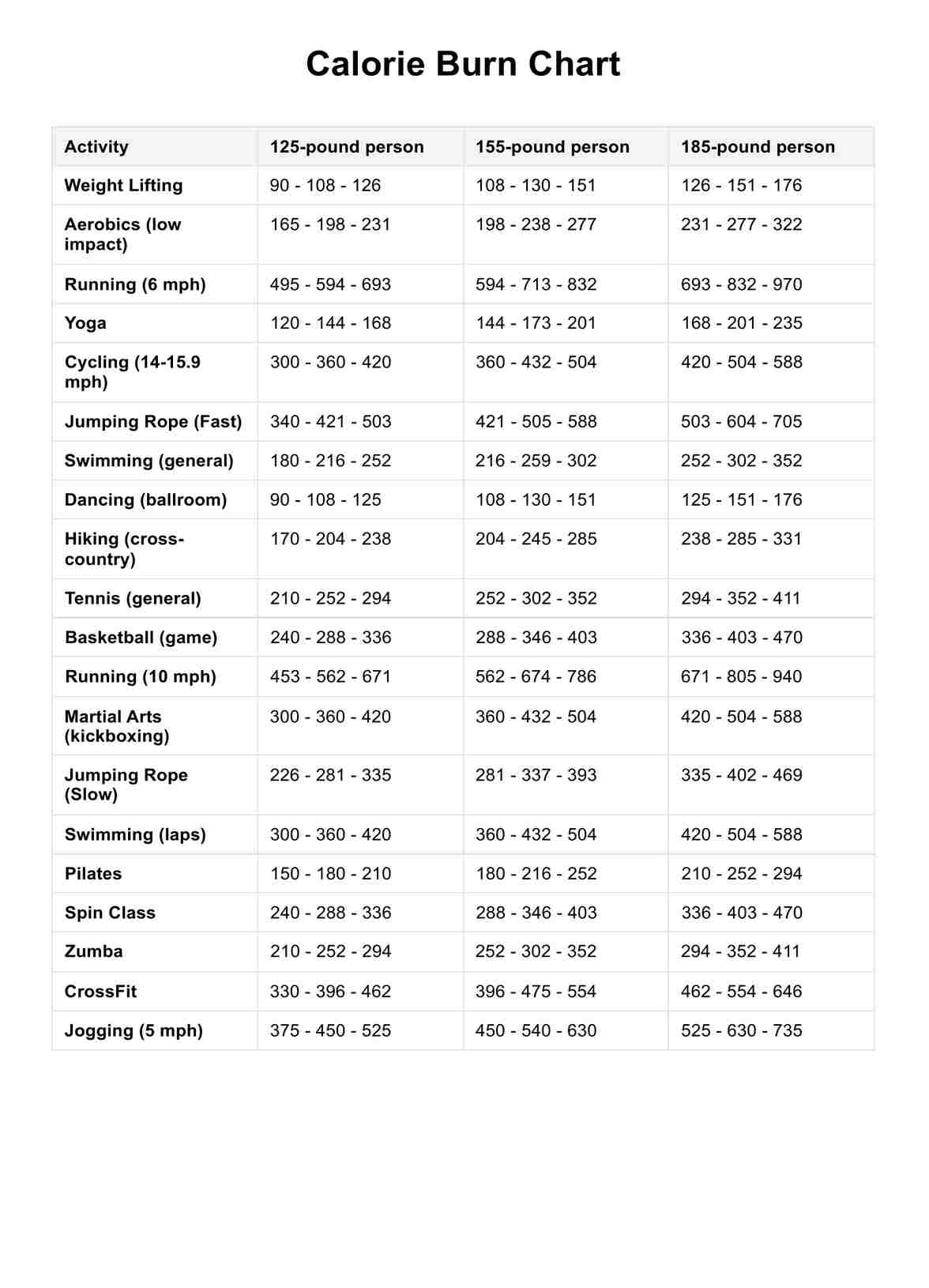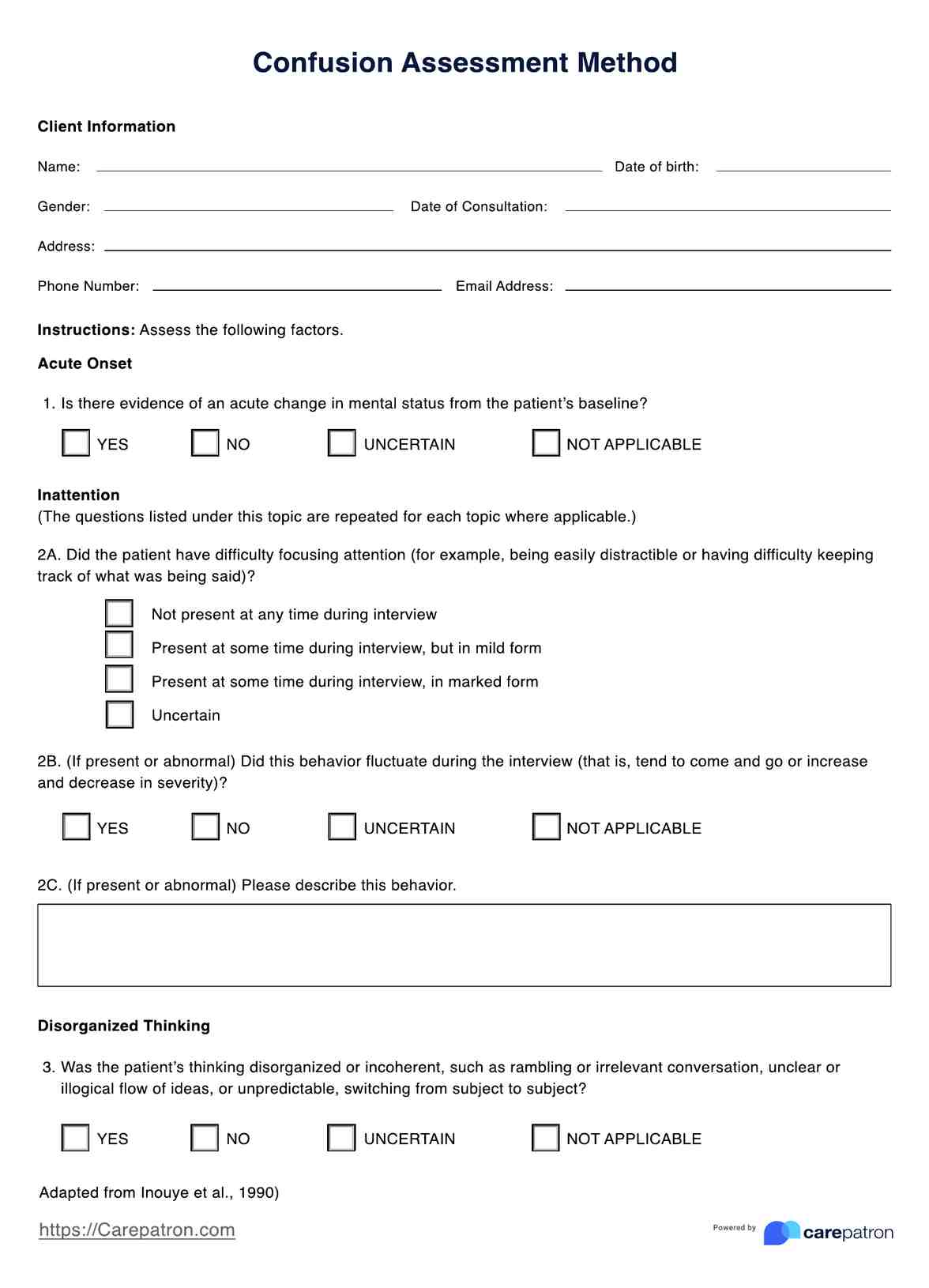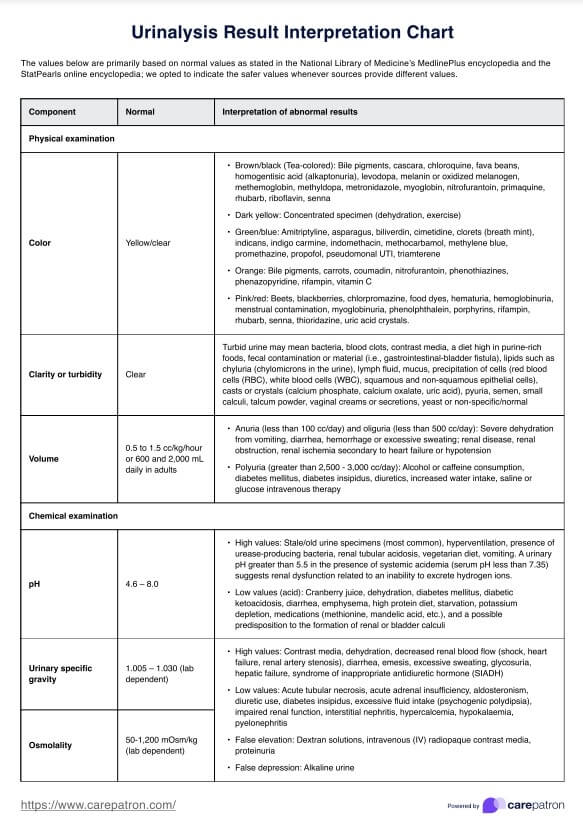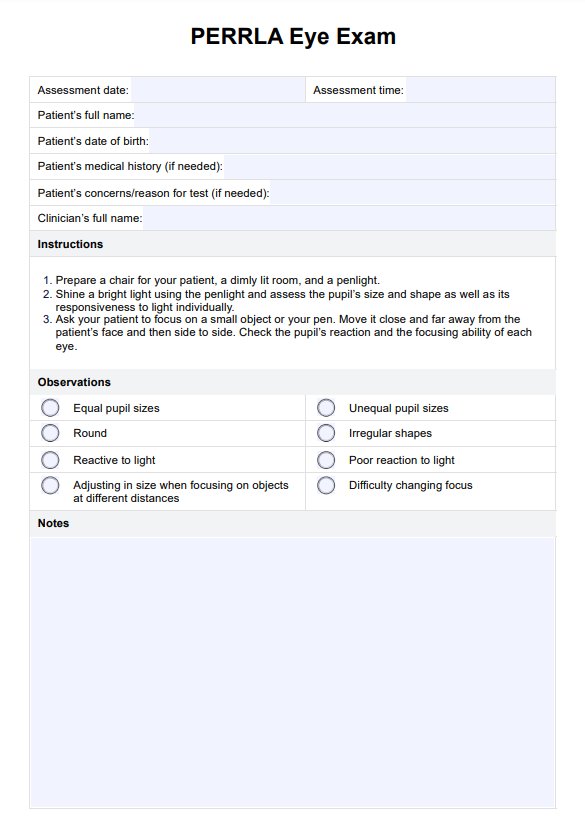UTI System Disorder Template
Creating a UTI System Disorder Template is essential to comprehensive care for patients. Discover the ins and outs of what to include in your plans with this guide!


What is a UTI System Disorder Template?
Urinary tract infections (UTIs) stem from pathogenic microorganisms that invade the kidney, bladder, or urethra. This infection is identified by significant bacteriuria paired with symptoms of cystitis or pyelonephritis, contributing to a substantial portion of emergency department visits, with around 20% of women having experienced at least one UTI (Brusch & Stuart, 2023).
Predominantly, UTIs are traced back to Escherichia coli (E. coli), a bacterium typically found in the digestive system. E. coli is responsible for most cases of uncomplicated cystitis. Typically, the body clears urinary tract-invading bacteria before symptoms emerge, but in some instances, these bacteria surpass the body's natural defenses, leading to infection. Uropathogenic bacteria, a subset of fecal flora, possess specific traits that encourage adhesion, growth, and resistance against the body's defenses, enabling the development of urinary tract infections (Brusch & Stuart, 2023).
UTIs are usually categorized as upper or lower urinary tract infections. Urethritis indicates an infection in the urethra, cystitis in the bladder, and pyelonephritis involves bacteria in the kidneys. Uncomplicated UTIs are typically confined to the bladder. Common symptoms include, but aren’t limited to:
- Dysuria
- Urinary urgency and frequency
- Bladder fullness
- Lower abdominal discomfort
- Suprapubic and flank tenderness
- Bloody urine
- Fever
- Chills
- Malaise
The identification of this system disorder aids in the creation of medical plans that aim to alleviate pain, educate patients on preventive measures and treatment, and manage potential complications.
UTI System Disorder Template
UTI System Disorder Template Example
How does it work?
Step One: Gather your resources
UTI system disorder templates are a valuable resource and essential to keep on hand. Make sure that you have a copy of the free printable PDF when the need arises by either clicking the “Download Template” or “Use Template” button or by searching “ UTI System Disorder template” on Carepatron’s template library’s search bar on the website or app.
Step Two: Collate essential information
Once the patient has been diagnosed with a UTI, utilizing the UTI system disorder template to ensure all goals of care are met is seamless and easily accessible to relevant parties via Carepatron's centralized workspace. Assessment, symptom management, and interventions can be collated within the single care plan and safely stored on a single database. The care plan allows for individualized treatment options and acts as a scaffolding to ensure goals of care are met, and the next steps are recorded for future reference or for distribution to other healthcare specialists who are part of the patient's care team.
Step Three: Store the chart securely
After reviewing the UTI system disorder template and creating a viable and individualized plan for the patient, you need to secure the plan so that access is only granted to relevant parties.
Ensure this through Carepatrons HIPAA-compliant free patient records software. Here, all relevant medical records can be safely stored and collated for ease and security.
When would you use this template?
A UTI System Disorder Template is employed in various healthcare scenarios where patients present with symptoms or a diagnosis of urinary tract infection. It's utilized in multiple settings and situations, some of which include:
Clinical Assessments
When conducting initial assessments or ongoing evaluations of patients suspected or diagnosed with UTIs. The template helps structure the assessment process, ensuring comprehensive evaluation of symptoms and guiding diagnostic procedures.
Hospital Admissions
During hospital admissions, especially for patients presenting with UTI-related symptoms. The template assists healthcare providers in standardizing the approach to diagnosis, treatment, and monitoring of UTIs in hospitalized individuals.
Outpatient Clinics
In outpatient settings, such as primary care clinics or specialized urology clinics, the template aids in systematically managing patients with UTIs, ensuring appropriate diagnostic tests, treatment plans, and follow-up care.
Nursing Care Plans
Within nursing care plans, particularly for patients in long-term care facilities or those receiving home healthcare. The template assists healthcare professionals in addressing UTIs as part of the overall care plan, focusing on prevention, management, and patient education.
Emergency Department Visits
For patients seeking urgent care due to severe UTI symptoms or complications. The template helps streamline assessments and expedite appropriate treatment measures.
Public Health and Education Programs
Outlines and templates for UTI system disorders can be used as part of a public health initiative aimed at raising awareness about UTIs, promoting prevention strategies, and educating individuals about symptoms and when to seek medical attention.
What do the results mean?
Once an assessment has been carried out to identify and diagnose infection, a UTI-specific system disorder template can assist in further assessment and interventions for meeting the patient's care goals. Common results and their respective care plans are outlined below:
Acute pain
Often, patients with a UTI describe a burning sensation paired with a sense of urgency and frequency to void. This pain is related to the disease and inflammatory processes and is linked to the infection. The patient may experience pain in their pelvis, dysuria, frequency, and burning with urination. In this situation, the expected outcomes from a disorder template involve reduced pelvic pain along with relief from burning and pain during urination.
Deficit fluid volume
A common consequence of the patient's symptoms relating to a UTI, deficient fluid volume, may be evidenced by an altered mental status, hypotension, decreased urine output, increased body temperature, and thirst. Goals of care within a disorder template would address the patient's blood pressure, temperature, pulse rate, and oxygen saturation. Ensuring all these vitals remain within a normal range. Another key expected outcome is the patient's urine output sitting at 0.5 ml/kg/hr or higher.
Disturbed sleep pattern
Because the infection causes an array of uncomfortable symptoms, such as dysuria and increased urgency, the patient may experience disrupted sleep patterns, which can be detrimental to health and healing. From a disorder template's expected outcomes, a patient's goals of care are met when they verbalize an improved sleeping pattern and reach a satisfactory level of rest and sleep. A key goal within this plan is to see the reduced need to wake more than once in the night to urinate.
Hyperthermia
This serious side effect requires a system disorder template to help mitigate elevated temperature, chills, and shivering. This particular aspect of a UTI plan may come into effect should the patient display flushed skin, lethargy, tachycardia, chills, and a temperature over 38.0 C /100.4 F. By instigating this chart, expected outcomes are that the patient maintains a body temperature within the normal limits and that the patient experiences no complications from an increased temperature, such as dehydration, chills, and potential seizures.
Impaired urinary elimination
A UTI may cause irregular urinary patterns through symptoms such as urinary retention, urgency, frequency, and nocturia. This potential anatomical dysfunction may be displayed through urinary incontinence and frequency, leading to the goal of having the patient report the ability to void without any pain or urgency. Another goal of care is that the patient will hold a normal urine output volume and void no more frequently than once every two hours.
Research & evidence
Urinary tract infections, including catheter-associated, represent one of the most frequently identified infections within residential aged care facilities, making up 12.6% to 50% of all infections within these settings (Bennett, Johnson, Richards, Smith, & Worth, 2016; Gharbi et al., 2019; Ryan, Gillespie, & Stuart, 2018). The heightened presence of urinary tract infections in aged care facilities can be linked to increased instances of cognitive and functional impairments and concurrent health conditions that disrupt normal voiding patterns in individuals (Jump et al., 2018).
The instigation of UTI system disorder templates within this setting is paramount as residents in aged care facilities often hold medical comorbidities such as dementia, diabetes, Parkinson's disease, and stroke, which can affect proper levels of self-hygiene, contribute to voiding irregularities (e.g., bladder incontinence), and an increased need for catheterization (Rowe & Juthani-Mehta, 2014). When dealing with patients who have cognitive impairments, managing their fluid intake and hydration levels can prove challenging as sensations of thirst and incomplete bladder emptying are impaired, leading to an increased risk of UTI development. Proper intervention and prevention are key within this population, making an easily accessed UTI system disorder template a crucial part of care.
Within the pregnant population, UTIs hold significance due to the potential complications and miscarriage risks associated with bacteriuria during pregnancy. Among pregnant women, UTI stands as the second most prevalent condition, following anemia, and ranks as the most widespread infection within this specific group of patients. Roughly 5% to 10% of women experience UTIs during their pregnancy, with approximately 5% of all admissions of pregnant women attributed to UTIs. Mismanagement of UTIs can significantly heighten the likelihood of pyelonephritis due to pregnancy-induced alterations in the urinary tract, leading to severe maternal and fetal complications like preterm labor, low birth weight, or maternal systemic infection (Szweda & Jóźwik, 2016). Proper management and utilization of a UTI system disorder template for this population is key.
References
Bennett, N. J., Johnson, S. A., Richards, M. J., Smith, M. A., & Worth, L. J. (2016). Infections in Australian Aged-Care Facilities: Evaluating the Impact of Revised McGeer Criteria for Surveillance of Urinary Tract Infections. Infection Control & Hospital Epidemiology, 37(5), 610–612. https://doi.org/10.1017/ice.2016.7
Jump, R. L. P., Crnich, C. J., Mody, L., Bradley, S. F., Nicolle, L. E., & Yoshikawa, T. T. (2018). Infectious Diseases in Older Adults of Long-Term Care Facilities: Update on Approach to Diagnosis and Management. Journal of the American Geriatrics Society, 66(4), 789–803. https://doi.org/10.1111/jgs.15248
Rowe, T. A., & Juthani-Mehta, M. (2013). Urinary tract infection in older adults. Aging Health, 9(5), 519–528. https://doi.org/10.2217/ahe.13.38
Ryan, S., Gillespie, E., & Stuart, R. L. (2018). Urinary tract infection surveillance in residential aged care. American Journal of Infection Control, 46(1), 67–72. https://doi.org/10.1016/j.ajic.2017.07.002
Szweda, H., & Jóźwik, M. (2016). Urinary tract infections during pregnancy - an updated overview. Developmental Period Medicine, 20(4), 263–272. https://pubmed.ncbi.nlm.nih.gov/28216479/
Commonly asked questions
To create a comprehensive system disorder template for UTI management, simply create a customized plan from the scaffolding provided by Carepatron and cater to the patient's needs through the key aspects of assessment, diagnosis, planning, intervention, and evaluation.
These valuable templates can be used at any point of the treatment journey for a patient with a UTI to track, monitor, and plan all interventions both by healthcare professionals and the patient themselves.
UTI system disorder templates are used as a planning tool for efficient and confident care delivery. They are designed to be customized and meet the individual patient's needs.


